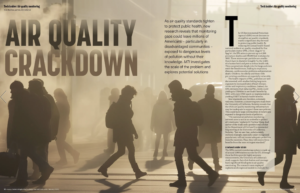As air quality standards tighten to protect public health, new research reveals that monitoring gaps could leave millions of Americans – particularly in disadvantaged communities – exposed to dangerous levels of pollution without their knowledge. MTI investigates the scale of the problem and explores potential solutions.
The US Environmental Protection Agency’s (EPA) recent decision to strengthen air quality standards marks a significant step forward in protecting public health. By reducing the annual health-based national ambient air quality standard for fine particulate matter (PM2.5) from 12µg/m3 to 9µg/m3 , the EPA aims to prevent up to 4,500 premature deaths and 290,000 lost workdays by 2032. These microscopic particles are smaller than 2.5µm in diameter (roughly 1⁄30 the width of a human hair) and pose a serious health risk. They can penetrate deeply into the lungs and even enter the bloodstream, leading to respiratory diseases, cardiovascular problems and premature death. Children, the elderly and those with pre-existing conditions are especially vulnerable.
The health impacts of PM2.5 pollution are well documented, with studies linking long-term exposure to increased rates of heart disease, stroke and respiratory conditions. Indeed, the EPA estimates that reducing PM2.5 levels could yield up to US$46bn in net health benefits by 2032, with every US$1 spent on implementation yielding US$77 in human health benefits.
New standards are, therefore, extremely welcome. However, a concerning new study from the University of California, Berkeley reveals that the USA’s air quality monitoring infrastructure may be inadequate to support these new policies. This could leave large communities of Americans exposed to dangerous levels of pollution.
“The national air pollution monitoring network aims to act as an umbrella to protect all Americans,” explains Dr Yuzhou Wang, lead author of the study and a postdoctoral scholar in the Department of Civil and Environmental Engineering at the University of California, Berkeley. “But we saw that, unfortunately, millions of people, especially under-recognized populations, will not receive adequate protection from the monitors. Thus, they will receive fewer benefits from the more stringent standard.”
A network under strain
The EPA’s current monitoring system is made up of around 1,000 stations across the US. Although these facilities provide highly accurate measurements, the University of California’s study suggests their distribution and coverage leave significant blind spots in air quality monitoring. The research team employed sophisticated empirical models to evaluate the network’s effectiveness. “We utilize monitoring data, satellite data and geographic characters as inputs and use statistical methods to predict concentration at fine spatial scale,” comments Dr Wang. “We compared the concentrations at the monitoring sites with concentrations at the rest of the locations.”
The team’s modeling approach combines traditional monitoring data with advanced satellite observations and geographic information systems, creating a comprehensive picture of air quality variations across different urban and suburban landscapes.
Specifically, the methodology drew upon data from the EPA’s State and Local Air Monitoring Stations (SLAMS) network and combined it with census-tract-level PM2.5 estimates from the Center for Air, Climate and Energy Solutions (CACES). Using a sophisticated model that achieved 77-83% accuracy in out-of-sample validation measurements, the research team analyzed three-year averaged concentrations from 2017-2019 across 894 core-based statistical areas (CBSAs) across the US. This comprehensive approach enabled researchers to identify areas where PM2.5 levels exceeded the new standards but were not being captured by existing monitoring stations. Particular attention was paid to demographic and socioeconomic factors in these under-monitored regions.
What this innovative methodology has revealed are significant gaps in coverage that traditional monitoring alone might have missed. The findings are stark. Nearly half (44%) of highly populated metropolitan areas in the US, affecting approximately 20 million people, have inadequate monitoring networks to comply with the new EPA air quality standards. Perhaps most troubling is that around 2.8 million people live in PM2.5 hot spots that are entirely uncaptured by the existing monitoring network.
Dr Wang explains the genesis of the research: “I have been working on actionable strategies for addressing exposure and exposure inequality for several years. The specific study was inspired by the release of the new PM2.5 standard. For the first time, EPA mentioned that it plans to adjust the monitoring network to better protect at-risk communities, including minority communities.”
Disproportionate impact

The study reveals a worrying pattern of inequality in monitoring coverage. PM2.5 hot spots identified through both monitoring data and predictive modeling show significantly higher percentages of people from minority communities and those with lower socioeconomic status than the overall population.
“This is because those populations are more likely to live in the highly polluted regions,” Dr Wang notes. “Those populations have less sociopolitical power to resist polluting facilities and were treated discriminately by some historical policies. Thus they bear disproportionately higher air pollution burdens. The monitoring gaps overlook many highly polluted regions, which have more influence on those under-recognized populations.”
Historical zoning practices and industrial development patterns have often concentrated pollution sources in or near disadvantaged communities. The current monitoring network’s blind spots effectively compound this environmental justice issue, making it harder to identify and address these legacy problems.

Furthermore, the sheer scale of the problem exceeds initial expectations. “Our hypothesis was that the monitors may miss capturing some highly polluted regions,” Dr Wang explains. “However, what we didn’t foresee was the gap being quite so large. Our research concluded that the monitor network may miss some 44% of the highly polluted regions, involving 20 million people, which is very serious.”
A path forward
The research team’s analysis suggests that strategic placement of additional monitoring stations could dramatically improve coverage. Their findings indicate that adding just 10 new monitors in carefully selected locations could reduce the population in uncaptured hot spots by 67%, from 2.8 million to 900,000 people.
“We recommend adding those monitors to comply with the new standard,” adds Dr Wang, whose team identified priority locations for new monitors across several states, including Texas, Ohio, California, Wisconsin, Pennsylvania, Missouri and Idaho.
“However, to improve the protection for the at-risk communities, we also recommend incorporating other high-resolution tools, including mobile monitoring, satellite data and low-cost sensors. With the right calibrations, those tools can improve monitoring coverage, especially for the under-recognized population groups,” Dr Wang continues.
The EPA’s new standards represent a crucial step forward in protecting public health, but their effectiveness will depend heavily on the ability to accurately measure and monitor air quality across all communities. The University of California, Berkeley’s report highlights the urgent need for a more comprehensive approach to air quality monitoring across the US.
The situation becomes even more pressing when considering future scenarios. Dr Wang points out, “With the stricter future standard coming into force, which aligns with World Health Organization guidelines (5µg/m3 ), the gap could be much larger. We believe that adding additional monitors is now a matter of urgency.”
But the challenge extends beyond simply adding more monitoring stations. As Dr Wang has outlined, the EPA will need to consider how new technologies can complement traditional monitoring methods. Low-cost sensors, mobile monitoring platforms and satellite-based systems could all play crucial roles in building a more comprehensive air quality monitoring network. However, ensuring the accuracy and reliability of these newer technologies will be crucial.
Dr Wang’s research team is now focusing on how to incorporate high-resolution tools into monitoring capabilities, and developing emission control strategies to help regions meet the new standard. She hopes that this ongoing work will continue to underscore the importance of not only setting ambitious standards but also ensuring the infrastructure to implement and enforce them is developed too.
Our Common Air calls for global air quality database
Our Common Air – an independent global commission of high-level government figures, health experts, academics and climate change specialists who are working to catalyze and accelerate global collective action on air pollution – is lobbying for the creation of a global air quality database to fill the important gaps in global air quality data.

“A global air quality database that categorizes national-level air quality – especially PM2.5, which has an outsized impact on human health relative to other common air pollutants – is a needed basic building block to establish the state of global air quality, build a strategic plan for advocating and disbursing funds geographically, and ultimately gauge progress,” comments Our Common Air commissioner Christa Hasenkopf, who is also director of the Clean Air Program at the Energy Policy Institute of the University of Chicago (EPIC) and the co-founder and former CEO of OpenAQ – an open-source platform of air quality data.
“Currently, there is no comprehensive, up-to-date global air quality database for air pollution, yet other major global health issues such as HIV/ AIDS and malaria have made progress by having an annually recurring report on country-level progress,” she adds.
Hasenkopf notes that such a database must be global with no country left behind, fully transparent and open source, and created to incentivize countries to lead the way on generating their own data and using models to estimate their national air pollution levels. “As part of that, the effort would need to find ways to offer financial resources to countries that do not yet have the full capability to generate such estimates,” Hasenkopf says.
“Technically, such an air quality database would require meshing satellite data with available ground monitoring data, and this would require both convening a committee of geographically representative scientific experts to develop best practices for countries to use, and helping countries self-assess what they need to advance their capacity to contribute to the database,” she continues.
The Our Common Air commission is now asking that UN agencies and major development and regional development banks play a critical role in coordinating and financing efforts to install at least one PM2.5 monitor in each country, ensuring real-time, open access to air quality data for the whole population.
Currently, many countries simply lack the infrastructure to effectively estimate their pollution levels. In a recent report called Accelerating Country-led Air Quality Reporting to Achieve Clean Air, Our Common Air, which was launched in 2024, notes that 39% of countries currently lack the capability to monitor PM2.5 effectively. “Air quality data gaps are an issue in much of Africa, Latin America and parts of Asia, where there is a lack of public air quality ground monitoring data across entire countries,” explains Hasenkopf.
Hasenkopf believes one solution could be to link low-cost air quality sensors with weather networks for easy deployment. She concludes, “There is value in deploying larger networks of lower-cost air quality sensors and attaching them to existing environmental sensing systems like weather networks. However, there needs to be a reliable way to calibrate the networks.”
This article originally appeared in the January 2025 issue of Meteorological Technology International. To view the magazine in full, click here.




